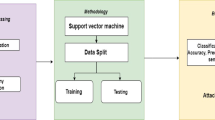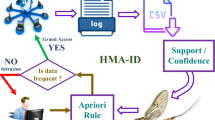Abstract
The security of a data is the data is the prime challenge in the current scenario. To protect our data from unauthorized access we need a system that analyses traffic to identify network attacks, as well as alert the user by generating an alarm. In recent times numerous intrusion detection models have been built to detect intrusion activity. In this paper, we proposed the most effective hybrid Intrusion detection system (IDS) based on association rule mining (ARM) and ant colony optimization (ACO) for the identification of the attacks. The standard NSL-KDD dataset and CICIoT2023 dataset is considered for evaluating the performance of the proposed hybrid approach. The novel ARM-ACO hybrid model outperforms in detection accuracy as well as in the very low false alarm rate. The major advancement in the proposed model is that it also considered the categorical data which is not evaluated or considered in the previous methodology on unbiased selection of a dataset. As compared to earlier methodologies, our results were superior in terms of categorization as well as accuracy. In NSL-KDD dataset the accuracy of the proposed model is 99.80%, with a very low false alarm rate and in CICIoT2023 dataset the accuracy is 99.93% which is much better than the previous approaches. The proposed ARM-ACO model clearly shows its outperformance in terms of accuracy as well as low false alarm rate.













Similar content being viewed by others
Data availability
The data and material of the manuscript is available.
Code availability
The code is available in GitHub.
References
Manimurugan S, Majdi A-Q, Mustaffa Mohmmed C, Narmatha RV (2020) Intrusion detection in networks using crow search optimization algorithm with adaptive neuro-fuzzy inference system. Microprocess Microsyst. https://doi.org/10.1016/j.micpro.2020.103261
Mhawi DN, Hashim SH (2023) Proposed Hybrid Ensemble Learning Algorithms for an Efficient Intrusion Detection System. Iraqi Journal of Computers, Communications, Control & Systems Engineering (IJCCCE). 22(2). https://doi.org/10.33103/uot.ijccce.22.2.7.
Ramesh Kumar M, Sudhakaran P (2024) Securing IoT networks: A robust intrusion detection system leveraging feature selection and LGBM. Peer-to-Peer Networking Applications 17:2921–2943. https://doi.org/10.1007/s12083-024-01721-y
Qasem AA, Qutqut MH, Alhaj F et al (2024) SRFE: A stepwise recursive feature elimination approach for network intrusion detection systems. Peer-to-Peer Networking Appl. https://doi.org/10.1007/s12083-024-01763-2
Nandhini U, SVN, S. (2024) An improved Harris Hawks optimizer based feature selection technique with effective two-staged classifier for network intrusion detection system. Peer-to-Peer Networking Appl 17:2944–2978. https://doi.org/10.1007/s12083-024-01727-6
Mashuqur Rahman Mazumder AKM, Mohammed Kamruzzaman N, Akter N, Arbe N, Rahman MM. (2021) Network intrusion detection using hybrid machine learning model. International Conference on Advances in Electrical, Computing, Communication and Sustainable Technologies (ICAECT). https://doi.org/10.1109/icaect49130.2021.9392483.
Narayanasami S, Sengan S, Khurram S, Arslan F, Murugaiyan SK, Rajan R, Peroumal V, Dubey AK, Srinivasan S, Sharma DK (2021) Biological feature selection and classification techniques for intrusion detection on BAT. Wireless Pers Commun. https://doi.org/10.1007/s11277-021-08721-8
Ramaiah M, Chandrasekaran V, Ravi V, Kumar N (2021) An intrusion detection system using optimized deep neural network architecture. Transactions Emerg Telecommun Technol. 32(4). https://doi.org/10.1002/ett.4221
Mighan SN, Kahani M (2020) A novel scalable intrusion detection system based on deep learning. Int J Inf Secur 20(3):387–403. https://doi.org/10.1007/s10207-020-00508-5
Maseer ZK, Yusof R, Bahaman N, Mostafa SA, Foozy CFM (2021) Benchmarking of machine learning for anomaly based intrusion detection systems in the CICIDS2017 dataset. IEEE Access 9:22351–22370. https://doi.org/10.1109/access.2021.3056614
Selvakumar B, Muneeswaran K (2019) Firefly algorithm based feature selection for network intrusion detection. Computers Secur 81:148–155. https://doi.org/10.1016/j.cose.2018.11.005
Subba B (2019) A neural network based NIDS framework for intrusion detection in contemporary network traffic. IEEE Int Conference Adv Networks Telecommun Systems (ANTS). https://doi.org/10.1109/ants47819.2019.9117966
Taher KA, Mohammed Yasin Jisan B, Rahman MM (2019) Network intrusion detection using supervised machine learning technique with feature selection. Int Confer Robotics, Electrical Signal Processing Techniques (ICREST). https://doi.org/10.1109/icrest.2019.8644161.
Shao Y, Liu B, Li G, Wang S (2017) Software defect prediction based on class-association rules. Second Int Conference Reliability Systems Eng (ICRSE). https://doi.org/10.1109/icrse.2017.8030774
Devan P, Khare N (2020) An efficient XGBoost–DNN-based classification model for network intrusion detection system. Neural Comput Appl 32(16):12499–12514. https://doi.org/10.1007/s00521-020-04708-x
Rajadurai H, Gandhi UD (2020) A stacked ensemble learning model for intrusion detection in wireless network. Neural Comput Appl. https://doi.org/10.1007/s00521-020-04986-5
Wei W, Chen S, Lin Q, Ji J, Chen J (2020) A multi-objective immune algorithm for intrusion feature selection. Appl Soft Comput 95:106522. https://doi.org/10.1016/j.asoc.2020.106522
Baek S, Kwon D, Suh SC, Kim H, Kim I, Kim J (2021) Clustering-based label estimation for network anomaly detection. Digital Commun Networks 7(1):37–44. https://doi.org/10.1016/j.dcan.2020.06.001
Kushwah GS, Ranga V (2020) Voting extreme learning machine based distributed denial of service attack detection in cloud computing. J Inform Security Appl 53:102532. https://doi.org/10.1016/j.jisa.2020.102532
Choudhary S, Kesswani N (2020) Analysis of KDD-Cup’99, NSL-KDD and UNSW-NB15 datasets using deep learning in IoT. Procedia Computer Science 167:1561–1573. https://doi.org/10.1016/j.procs.2020.03.367
Almiani M, AbuGhazleh A, Al-Rahayfeh A, Atiewi S, Razaque A (2020) Deep recurrent neural network for IoT intrusion detection system. Simulation Modeling Practice Theory 101:102031. https://doi.org/10.1016/j.simpat.2019.102031
Singh S, Banerjee S (2020) Machine learning mechanisms for network anomaly detection system: A review. Int Conference Commun Signal Processing (ICCSP). https://doi.org/10.1109/iccsp48568.2020.9182197
Abrar I, Ayub Z, Masoodi F, Bamhdi AM (2020) A machine learning approach for intrusion detection system on NSL-KDD dataset. Int Conference Smart Electronics Commun (ICOSEC). https://doi.org/10.1109/icosec49089.2020.9215232
Su T, Sun H, Zhu J, Wang S, Li Y (2020) BAT: deep learning methods on network intrusion detection using NSL-KDD dataset. IEEE Access 8:29575–29585. https://doi.org/10.1109/access.2020.2972627
Almasoudy FH, Al-Yaseen WL, Idrees AK (2020) Differential evolution wrapper feature selection for intrusion detection system. Procedia Computer Sci 167:1230–1239. https://doi.org/10.1016/j.procs.2020.03.438
Kunal, Dua M (2020). Attribute selection and ensemble classifier based novel approach to intrusion detection system. Procedia Computer Sci. 167:2191–2199https://doi.org/10.1016/j.procs.2020.03.271
Yu Y, Bian N (2020) An intrusion detection method using few-shot learning. IEEE Access 8:49730–49740. https://doi.org/10.1109/access.2020.2980136
Tavallaee M, Bagheri E, Lu W, Ghorbani AA (2009) A detailed analysis of the KDD CUP 99 data set. Computational Intell Security. https://doi.org/10.1109/cisda.2009.5356528
Behal S, Kumar K (2016) Trends in validation of DDoS research. Procardia Computer Sci 85:7–15. https://doi.org/10.1016/j.procs.2016.05.170
Khraisat A, Gondal I, Vamplew P, Kamruzzaman J (2019) Survey of intrusion detection systems techniques, datasets and challenges. Cyber Security. 2(1). https://doi.org/10.1186/s42400-019-0038-7.
Balasaraswathi VR, Sugumaran M, Hamid Y (2017) Feature selection techniques for intrusion detection using non-bio-inspired and bio-inspired optimization algorithms. J Commun Inform Networks 2(4):107–119. https://doi.org/10.1007/s41650-017-0033-7
Tsai C, Hsu YF, Lin C, Lin W (2009) Intrusion detection by machine learning: A review. Expert Syst Appl 36(10):11994–12000. https://doi.org/10.1016/j.eswa.2009.05.029
Behal S, Kumar K (2016) Trends in validation of DDoS research. Procedia Computer Sci 85:7–15. https://doi.org/10.1016/j.procs.2016.05.170
Ibrahim ZK, Thanon MY (2021) Performance comparison of intrusion detection system using three different machine learning algorithms. 6th International Conference on Inventive Computation Technologies (ICICT). 1116–1124, https://doi.org/10.1109/ICICT50816.2021.9358775.
Parimala G, Kayalvizhi R (2021). An effective intrusion detection system for securing IoT using feature selection and deep learning. Int Conference Comp Commun Informatics (ICCCI). 1–4. https://doi.org/10.1109/ICCCI50826.2021.9402562.
Stiawan D et al (2021) An approach for optimizing ensemble intrusion detection systems. IEEE Access 9:6930–6947. https://doi.org/10.1109/ACCESS.2020.3046246
Li L-H, Ahmad R, Tsai W-C, Sharma AK (2021) A feature selection based DNN for intrusion detection system. 15th International Conference on Ubiquitous Information Management and Communication (IMCOM). 1–8, https://doi.org/10.1109/IMCOM51814.2021.9377405.
Ibrahim ZK, Thanon MY (2021) Performance comparison of intrusion detection system using three different machine learning algorithms. International Conference on Inventive Computation Technologies (ICICT). 1116–1124. https://doi.org/10.1109/ICICT50816.2021.9358775.
Saber A, Abbas M, Fergani B (2021) Two-dimensional intrusion detection system: a new feature selection technique. 2nd International Workshop on Human-Centric Smart Environments for Health and Well-being (IHSH), 69–74. https://doi.org/10.1109/IHSH51661.2021.9378721.
Sharma M, Sharma M, Elmiligi H, Gebali F (2021) A novel intrusion detection system for RPL-based cyber-physical systems. IEEE Canadian J Elec Comp Eng. https://doi.org/10.1109/ICJECE.2021.3053231
Ahmad HamdiQaiwmchi N, Amintoosi H, Mohajerzadeh A (2021) Intrusion detection system based on gradient corrected online sequential extreme learning machine. IEEE Access 9:4983–4999. https://doi.org/10.1109/ACCESS.2020.3047933
Jiang L, Kong G, Li C (2021) Wrapper framework for test-cost-sensitive feature selection. IEEE Transactions on Systems, Man, and Cybernetics: Systems 51(3):1747–1756. https://doi.org/10.1109/TSMC.2019.2904662
Lifandali O, Abghour N, Chiba Z (2023) Feature selection using a combination of ant colony optimization and random forest algorithms applied to isolation forest based intrusion detection system. Procedia Computer Science 220:796–805. https://doi.org/10.1016/j.procs.2023.03.106
Alsarhan A, Alauthman M, Alshdaifat E, Al-Ghuwairi AR, Al-Dubai A (2021) Machine learning-driven optimization for svm-based intrusion detection system in vehicular ad hoc networks. J Ambient Intell Humaniz Comput. https://doi.org/10.1007/s12652-021-02963-x
Oleiwi HW, Mhawi DN, Al-Raweshidy H (2022). MLTs-ADCNs: Machine Learning Techniques for Anomaly Detection in Communication Networks. In IEEE Access, 10:91006–91017. https://doi.org/10.1109/ACCESS.2022.3201869.
Mhawi DN, Aldallal A, Hassan S (2022) Advanced Feature-Selection-Based Hybrid Ensemble Learning Algorithms for Network Intrusion Detection Systems. Symmetry 14(7):1461. https://doi.org/10.3390/sym14071461
Kocher G, Kumar G (2021) Machine learning and deep learning methods for intrusion detection systems: recent developments and challenges. Soft Comput 25:9731–9763. https://doi.org/10.1007/s00500-021-05893-0
Lo W, Alqahtani H, Thakur K, Almadhor A, Chander S, Kumar G (2022) A hybrid deep learning based intrusion detection system using spatial-temporal representation of in-vehicle network traffic, Vehicular Communications, Volume 35. ISSN 100471:2214–2096. https://doi.org/10.1016/j.vehcom.2022.100471
Gulshan Kumar, Hamed Alqahtani (2022). Machine Learning Techniques for Intrusion Detection Systems in SDN-Recent Advances, Challenges and Future Directions, CMES - Computer Modeling in Engineering and Sciences. 134(1):89–119, ISSN 1526–1492, https://doi.org/10.32604/cmes.2022.020724
Kumar G, Kumar K, Sachdeva M (2010) The use of artificial intelligence based techniques for intrusion detection: a review. Artif Intell Rev 34:369–387. https://doi.org/10.1007/s10462-010-9179-5
Kumar G, Kumar K (2011) An information theoretic approach for feature selection. Security Commun Networks J 5:178–185. https://doi.org/10.1002/sec.303
Kumar G, Kumar K (2013) Design of an Evolutionary Approach for Intrusion Detection. Scientific World J. https://doi.org/10.1155/2013/962185
Dwivedi S, Vardhan M, Tripathi S (2021) Building an Efficient Intrusion detection system using grasshopper optimization algorithm for anomaly detection. Clust Comput 24(3):1881–1900. https://doi.org/10.1007/s10586-020-03229-5
Sumaiya Thaseen I, Saira Banu J, Lavanya K, Rukunuddin Ghalib M, Abhishek K (2020) An integrated intrusion detection system using correlation based attribute selection and artificial neural network. Transact Emerg Telecommun Technol. 32(2). https://doi.org/10.1002/ett.4014
Ahmad Z, Shahid Khan A, Wai Shiang C, Abdullah J, Ahmad F (2020) Network intrusion detection system: A systematic study of machine learning and deep learning approaches. Transact Emerg Telecommun Technol. 32(1), https://doi.org/10.1002/ett.4150.
Dubey S, Gupta C (2024) An Effective Model for Binary and Multi-classification Based on RFE and XGBoost Methods in Intrusion Detection System. Cyber Security and Digital Forensics. Lecture Notes in Networks and Systems, vol. 896. Springer, Singapore. https://doi.org/10.1007/978-981-99-9811-1_3.
Gupta C, Kumar A, Jain NK (2024) An Enhanced Hybrid Intrusion Detection Based on Crow Search Analysis Optimizations and Artificial Neural Network. Wireless Personal Commun 134:43–68. https://doi.org/10.1007/s11277-024-10880-3
Gupta C, Kumar A, Jain NK (2023) A Detailed Analysis on Intrusion Detection Systems, Datasets, and Challenges. Advances in Data Science and Computing Technologies. ADSC 2022. Lecture Notes in Electrical Engineering, vol 1056. Springer, Singapore. https://doi.org/10.1007/978-981-99-3656-4_26.
Gheni HQ, Al-Yaseen WL (2024) Two-step data clustering for improved intrusion detection system using CICIoT2023 dataset, e-Prime - Advances in Electrical Engineering, Electronics and Energy, Volume 9. ISSN 100673:2772–6711. https://doi.org/10.1016/j.prime.2024.100673
Neto ECP, Dadkhah S, Ferreira R, Zohourian A, Lu R, Ghorbani AA (2023) CICIoT2023: A Real-Time Dataset and Benchmark for Large-Scale Attacks in IoT Environment. Sensors 23(13):5941. https://doi.org/10.3390/s23135941
Funding
For conducting this study No funding was received.
Author information
Authors and Affiliations
Contributions
C.G. developed the theoretical formalism, performed the analytic calculations, conducted the numerical simulations, designed the model and computational framework, and analyzed the data. A.K. helped supervise the project, provided critical feedback, and contributed to shaping the research, analysis, and manuscript. N.K.J. conceived the study, oversaw the overall direction and planning, ensured the flow of the paper, and performed professional and comprehensive proofreading. All authors reviewed the manuscript.
Corresponding author
Ethics declarations
Conflicts of interest
There is no conflict of interest.
Additional information
Publisher's Note
Springer Nature remains neutral with regard to jurisdictional claims in published maps and institutional affiliations.
This article is part of the Tropical Collection: Track on Security and Privacy
Guest Editor: Rongxing Lu
Rights and permissions
Springer Nature or its licensor (e.g. a society or other partner) holds exclusive rights to this article under a publishing agreement with the author(s) or other rightsholder(s); author self-archiving of the accepted manuscript version of this article is solely governed by the terms of such publishing agreement and applicable law.
About this article
Cite this article
Gupta, C., Kumar, A. & Jain, N.K. Intrusion defense: Leveraging ant colony optimization for enhanced multi-optimization in network security. Peer-to-Peer Netw. Appl. 18, 98 (2025). https://doi.org/10.1007/s12083-025-01911-2
Received:
Accepted:
Published:
DOI: https://doi.org/10.1007/s12083-025-01911-2




